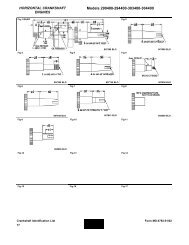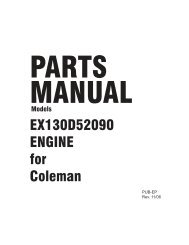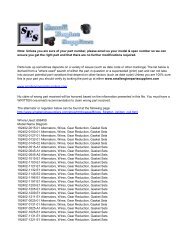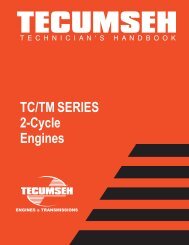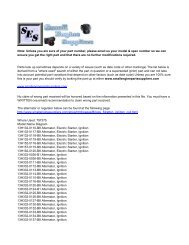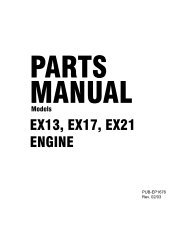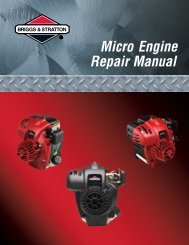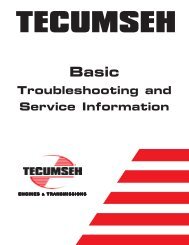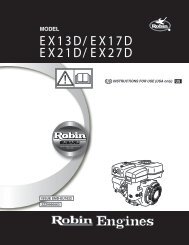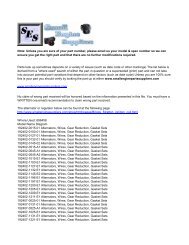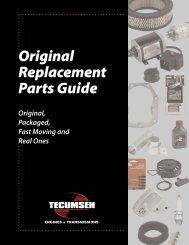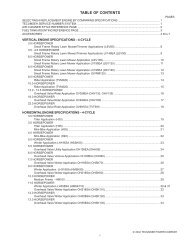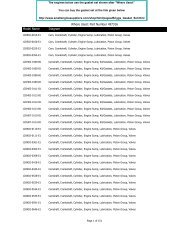3to 11hp 4-cycle l-head engines - Small Engine Suppliers
3to 11hp 4-cycle l-head engines - Small Engine Suppliers
3to 11hp 4-cycle l-head engines - Small Engine Suppliers
Create successful ePaper yourself
Turn your PDF publications into a flip-book with our unique Google optimized e-Paper software.
SERVICE<br />
If the brake system fails to kill the ignition and stop the blade within 3 seconds the following service procedures<br />
should be followed.<br />
FLYWHEEL REMOVAL<br />
NOTE: BEFORE THE FLYWHEEL IS REMOVED OR REPLACED, THE BRAKE PRESSURE ON THE FLYWHEEL<br />
MUST BE RELIEVED AS OUTLINED BELOW UNDER "BRAKE LEVER AND PAD".<br />
Remove the flywheel as outlined in Chapter 9 under "Disassembly".<br />
BRAKE LEVER AND PAD<br />
Bottom Surface<br />
UNHOOK TORSION SPRING<br />
To relieve the brake pressure on the flywheel, remove<br />
the torsion spring by firmly grasping the short end of<br />
the spring with a pliers and unhook the spring from the<br />
bracket then remove the flywheel (diag. 6).<br />
Remove the brake lever and pad assembly. Inspect the<br />
brake pad for dirt, oil or grease contamination. If the<br />
pad is contaminated, or if there is less than .060" (1.524<br />
mm) of brake pad material at the pad's thinnest point,<br />
replacement is necessary. The brake pad is bonded to<br />
the brake lever and must be replaced as an assembly.<br />
Install the brake lever and pad assembly and continue<br />
to reassemble the brake system in the reverse order of<br />
disassembly.<br />
NOTE: WHEN REMOVING THE BRAKE BRACKET THE<br />
TORSION SPRING MUST BE RELEASED BEFORE THE<br />
TOP STARTER BOLT IS REMOVED OR THE THREADS<br />
IN THE CYLINDER BLOCK WILL BE DAMAGED.<br />
SHORT END OF SPRING<br />
ALIGN HOLES<br />
6<br />
Inside Edge<br />
SWITCH<br />
LEVER<br />
670298<br />
To relieve the brake pressure on the flywheel, compress<br />
the spring by moving the lever toward the spark plug,<br />
when the hole in the lever aligns with the hole in the<br />
bracket, secure the lever with alignment tool 670298<br />
then remove the flywheel (diag. 7). Remove the alignment<br />
tool. Release the spring tension by unhooking the short<br />
end of the spring from bracket with a pliers. Remove<br />
the “E” clip from the brake pad shaft. Slide the pad lever<br />
from the shaft and unhook the link. Inspect the brake<br />
pad for dirt, oil or grease contamination. If the pad is<br />
contaminated, or if there is less than .060" (1.524 mm)<br />
of brake pad material at the pad's thinnest point,<br />
replacement is necessary. The brake pad is bonded to<br />
the brake lever and must be replaced as an assembly.<br />
Rehook the link, install the brake lever and pad assembly,<br />
install the "E" clip, rehook the short end of the spring<br />
and continue to reassemble the brake system in the<br />
reverse order of disassembly.<br />
GROUNDING CLIP<br />
GROUNDING CLIP POSITION<br />
LINKAGE<br />
7<br />
8<br />
IGNITION GROUNDOUT TERMINAL<br />
Inspect the ignition kill switch grounding clip for proper<br />
alignment and contact with the brake arm. Insure that<br />
all electrical connections are clean and secure (diag. 8<br />
& 9).<br />
"E" CLIP<br />
BRAKE PAD<br />
9<br />
61



